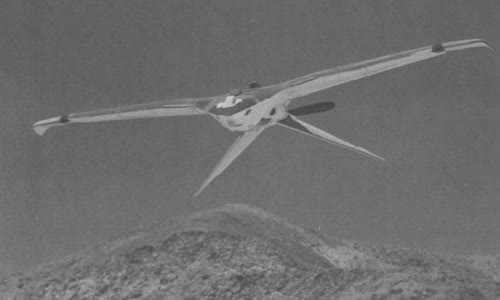The CIA in the 1960s carried out the Falcon Project to build a stealthy UAV model powered by nuclear energy to spy on the Soviet Union.
After the Soviet shoot-down of the US U2 reconnaissance plane controlled by pilot Francis Gary Powers in 1960, Washington thought manned reconnaissance flights over Moscow became too politically dangerous.

The Falcon strategy spy plane that the CIA once developed Photo: CIA
Therefore, the Central Intelligence Agency of America (CIA) proposed the Falcon Project, in order to develop an unmanned aircraft shaped like a large bird spreading its wings in the wind, looking from afar.
"Small, low and slow aircraft, equipped with image, sound and radar sensors, can bypass gaps in enemy air defenses, instead of using suppressive firepower," according to
"Falcon" has a wingspan of more than 3 meters, hardware manufactured by the McDonnell Douglas Group, with at least 5 prototypes created and tested.
Because of its low cost, inability to spark war and unmanned vehicles, the "Falcon" is judged more suitable politically than manned aircraft, and does not provoke similar responses.
"The eagle's ability to operate in secret means that it can safely penetrate thousands of kilometers deep inside the territory of the Soviet Union, China or Cuba," the declassified document said.
As planned, "Falcon" will carry a range of equipment for reconnaissance in close range at sensitive locations.
The data will be sent to headquarters via a C-47 mechanical transport that acts as an intermediary to transmit information.
The declassified document also said that "Falcon" is also capable of dropping intelligence-gathering equipment on enemy territory for use by agents on the ground.
Most of the "Falcon" specifications were censored by the CIA, but one document said the UAV had a maximum range of over 1,930 km.
In the days without GPS, navigating drones was a very difficult problem.
The Falcon Project operator is located in Area 51. Upon entry into the campaign, the mobile group carrying aircraft and radio control equipment will be transported by air to the operational site, such as the base.
Each mission is carried out along a planned route and rehearsal.
The most "revealing heavenly" disclosure in declassified documents is the "Falcon" upgrade plan with a nuclear-powered engine.
"It is predicted that the first test flight for a UAV with an integrated nuclear-powered engine will take off in fiscal 1973. In theory, this system will help the aircraft operate.
Another paragraph in the document states that "Falcon version of the upgrade" can operate on the target for 120 consecutive days, a clear indication that it uses a nuclear-powered engine.
The UAV uses nuclear power, which was planned to be operational by the United States in 1974. Although the US space and space agency (NASA) uses nuclear engines to power the exploration equipment.
Fortunately, the prospect of the Soviet Union shooting down a CIA-powered UAV and leaking radioactive material never happened, as the Falcon Project was suspended before it went into service.
According to Lieutenant Colonel John Meierdierck, the project's leader, the problem lies in a disagreement between the CIA and the McDonnell Douglas Group.
Instead of negotiating for a reasonable price, McDonnell Douglas decided to defend his position.
According to Forbes commentator David Hambling, Falcon is the project ahead of its time.
The CIA also developed a laser-guided dragonfly-shaped UAV at the same time as the Falcon Project, indicating that they have not completely abandoned the idea.
"However, we may not know about the current CIA spy drone technology, until they decode the document in the next 50 years," the commentator said.



 Emellyam Lynne
Emellyam Lynne







